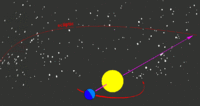Ecliptic facts for kids
The ecliptic is the apparent path that the Sun traces out in the sky during the year. As it appears to move in the sky in relation to the stars, the apparent path aligns with the planets throughout the course of the year. It is the intersection of a spherical surface, the celestial sphere, with the ecliptic plane, which is the geometric plane containing the mean orbit of the Earth around the Sun.
The ecliptic plane should be distinguished from the invariable plane. This is the average plane of the orbits of the planets. More precisely, it is perpendicular to the vector sum of the angular momenta of all planetary orbital planes, to which Jupiter is the main contributor. The present ecliptic plane is inclined to the invariable ecliptic plane by about 1.5°.
The name ecliptic is derived from being the place where eclipses occur.
Contents
Sun's apparent motion
The motions as described above are simplifications. Due to the movement of Earth around the Earth–Moon center of mass, the apparent path of the Sun wobbles slightly, with a period of about one month. Due to further perturbations by the other planets of the Solar System, the Earth–Moon barycenter wobbles slightly around a mean position in a complex fashion. The ecliptic is actually the apparent path of the Sun throughout the course of a year.
Because Earth takes one year to orbit the Sun, the apparent position of the Sun takes one year to make a complete circuit of the ecliptic. With slightly more than 365 days in one year, the Sun moves a little less than 1° eastward every day. This small difference in the Sun's position against the stars causes any particular spot on Earth's surface to catch up with (and stand directly north or south of) the Sun about four minutes later each day than it would if Earth would not orbit; a day on Earth is therefore 24 hours long rather than the approximately 23-hour 56-minute sidereal day. Again, this is a simplification, based on a hypothetical Earth that orbits at uniform speed around the Sun. The actual speed with which Earth orbits the Sun varies slightly during the year, so the speed with which the Sun seems to move along the ecliptic also varies. For example, the Sun is north of the celestial equator for about 185 days of each year, and south of it for about 180 days. The variation of orbital speed accounts for part of the equation of time.
Relationship to the celestial equator
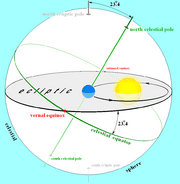
Because Earth's rotational axis is not perpendicular to its orbital plane, Earth's equatorial plane is not coplanar with the ecliptic plane, but is inclined to it by an angle of about 23.4°, which is known as the obliquity of the ecliptic. If the equator is projected outward to the celestial sphere, forming the celestial equator, it crosses the ecliptic at two points known as the equinoxes. The Sun, in its apparent motion along the ecliptic, crosses the celestial equator at these points, one from south to north, the other from north to south. The crossing from south to north is known as the vernal equinox, also known as the first point of Aries and the ascending node of the ecliptic on the celestial equator. The crossing from north to south is the autumnal equinox or descending node.
The orientation of Earth's axis and equator are not fixed in space, but rotate about the poles of the ecliptic with a period of about 26,000 years, a process known as lunisolar precession, as it is due mostly to the gravitational effect of the Moon and Sun on Earth's equatorial bulge. Likewise, the ecliptic itself is not fixed. The gravitational perturbations of the other bodies of the Solar System cause a much smaller motion of the plane of Earth's orbit, and hence of the ecliptic, known as planetary precession. The combined action of these two motions is called general precession, and changes the position of the equinoxes by about 50 arc seconds (about 0.014°) per year.
Once again, this is a simplification. Periodic motions of the Moon and apparent periodic motions of the Sun (actually of Earth in its orbit) cause short-term small-amplitude periodic oscillations of Earth's axis, and hence the celestial equator, known as nutation. This adds a periodic component to the position of the equinoxes; the positions of the celestial equator and (vernal) equinox with fully updated precession and nutation are called the true equator and equinox; the positions without nutation are the mean equator and equinox.
Plane of the Solar System
Most of the major bodies of the Solar System orbit the Sun in nearly the same plane. This is likely due to the way in which the Solar System formed from a protoplanetary disk. Probably the closest current representation of the disk is known as the invariable plane of the Solar System. Earth's orbit, and hence, the ecliptic, is inclined a little more than 1° to the invariable plane, and the other major planets are also within about 6° of it. Because of this, most Solar System bodies appear very close to the ecliptic in the sky. The ecliptic is well defined by the motion of the Sun. The invariable plane is defined by the angular momentum of the entire Solar System, essentially the summation of all of the orbital motions and rotations of all the bodies of the system, a somewhat uncertain value that requires precise knowledge of every object in the system. For these reasons, the ecliptic is used as the reference plane of the Solar System out of convenience.
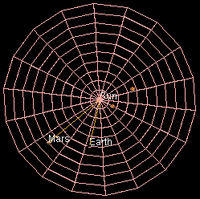 |
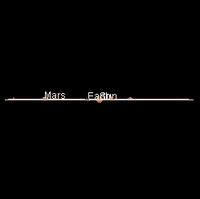 |
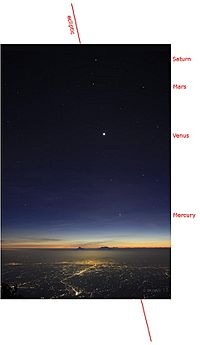 |
| Top and side views of the plane of the ecliptic, showing planets Mercury, Venus, Earth, and Mars. Most of the planets orbit the Sun very nearly in the same plane in which Earth orbits, the ecliptic. | Four planets lined up along the ecliptic in July 2010, illustrating how the planets orbit the Sun in nearly the same plane. Photo taken at sunset, looking west over Surakarta, Java, Indonesia. | |
Images for kids
See also
 In Spanish: Eclíptica para niños
In Spanish: Eclíptica para niños


